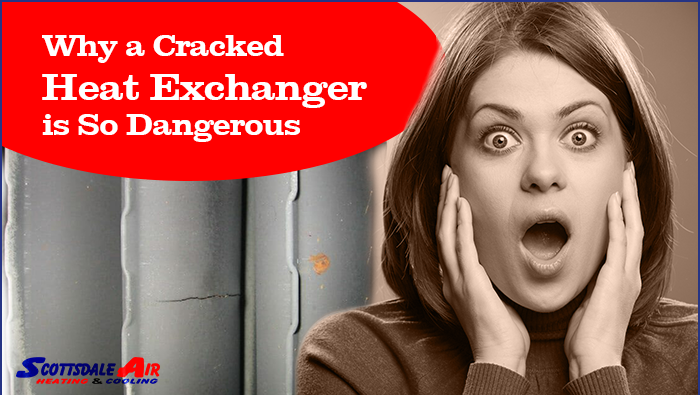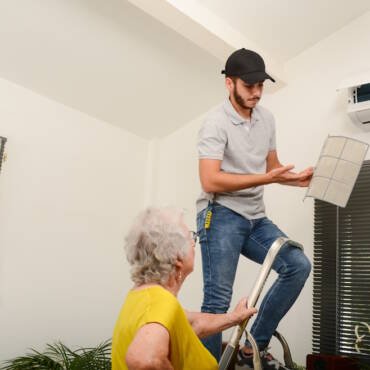Here’s what you need to know about maintaining your heating system.
A Cracked Heat Exchanger is Dangerous
When you’re dealing with a gas-powered furnace in your home, you have a powerful tool for staying comfortable in any weather.
However, you also have a volatile set up that could cause you serious problems if you’re not careful.
Playing with gas and fire is never a joke when you’re worried about the safety of your family and loved ones.
Gas-powered heaters are the most popular heating system in homes all across the country.
When it gets cold, a gas-powered heater can fight the elements quickly and make the inside of your home feel comfortable.
In homes that are significantly colder than others during the winter, they’re an essential part of your home.
They’re a cost-effective solution for homeowners and renters alike.
However, when they’re in a dangerous state, that can lead to natural gas leaks, offering many different problems.
Not only could a gas leak be toxic to pets, children, and the elderly, but there could also be combustion problems leading to fire or explosion.
One of the most common ways for this to be a problem is when there’s an issue with the heat exchanger.
A crack in your heat exchanger can turn your tool fo comfort into something much more dangerous.
Ignoring a cracked heat exchanger could be deadly and costly. If you suspect you have one, you need it fixed quickly.
If you call someone and they merely look at it, you’ve called the wrong person.
You need a professional ready to fix the issue.
Understanding Heat Exchangers
If you’re not well acquainted with your heating system, you should change that.
Knowledge is power in this case and it’s not only a way to save money on repairs but a way to identify problems that are beyond your ability to solve.
Your heat exchanger is a component applying heat to the air that your blower uses.
The blower then sends that air into a ventilation system via its fan which then gets sent into your home.
If you see a clam-shell shaped petal chamber or a number of them arranged in rows in your furnace system, you’ve likely identified your heat exchanger.
This is the place where the hot gas from combustion inside your burners collects and is dispursed.
The intense heat that comes from this gas will raise the temperature of the walls of the exchanger.
The heat exchanger will be hot to the touch.
The furnace then applies the heat of this combustion gas into the air while filtering out the gas itself, keeping it from being in contact with the air.
That’s how you can use a gas combustion heater without inhaling any of the exhaust or by-products as you would if you were using an internal combustion engine you’d find in a car.
How Cracks are Caused
Heat exchangers in a furnace are under constant pressure throughout years of use. Metal equipment is relied upon for its durability but it lacks the ability to contract and expand with heat when it’s subjected to extreme cold and heat.
Every time that your heat exchanger heats up, the metal is going to expand.
Over time, the cycle of expansion and contraction is going to weaken the metal.
This will cause corrosion over time and even cracks.
Older furnaces face a much higher risk of this than newer ones.
It’s also a problem when furnaces aren’t venting as well as they should.
Furnaces that have suffered from years of neglect or a lack of maintenance may also suffer cracks.
Corrosion weakens metal and the stress on the heat exchanger along with the air pressure is going to lead to small cracks.
These might not even be visible to the naked eye but they’ll cause serious issues of health and safety.
You need someone to run a check and apply a fix, more than just looking at or investigating the issue.
The Real Dangers
With cracks being invisible to many homeowners, the challenges to noting when it’s time to repair a heat exchanger might not be clear.
When the component heats up, that’s when the cracks will expand and when gas will be released.
This happens whether or not the homeowner recognizes it and leads to toxic gas ending up in their living space instead of being vented into the flue.
The gas is more than just any gas. The most common gas is CO or carbon monoxide.
When you’re exposed to this gas, you may feel dizziness, nausea, or a feeling of being lightheaded.
CO exposure is not only uncomfortable but potentially fatal. The danger of a cracked heat exchanger must be heeded carefully.
By keeping up on your furnace maintenance, ensuring that your carbon monoxide detectors are in good condition, and there’s proper ventilation, everyone is safe.
Work with your trusted Scottsdale heating maintenance company to do your best to prevent problems before they arise.
If you suspect there’s already a problem, then call for emergency HVAC services.
Maintain Your HVAC System
When you’re trying to keep your home both safe and comfortable, you need a high-quality HVAC system that gets regular maintenance.
Failure to maintain it will be both costly and dangerous, especially if you end up with a cracked heat exchanger.
If your furnace is well-maintained but not heating your home properly, check out our guide for tips.
Are you concerned about your Heating System or Heat Exchanger? The team at Scottsdale Air Heating & Cooling can service your heating system and tell you if you have a leak. Call 480-467-3586 or request service online! ….*Yes, We DO offer Financing Options.
Whether you require installation, repair, or maintenance, our technicians will assist you with top-quality service at any time of the day or night. Take comfort in knowing your indoor air quality is the best it can be with MOE heating & cooling services Ontario's solution for heating, air conditioning, and ventilation that’s cooler than the rest.
Contact us to schedule a visit. Our qualified team of technicians, are always ready to help you and guide you for heating and cooling issues. Weather you want to replace an old furnace or install a brand new air conditioner, we are here to help you. Our main office is at Kitchener but we can service most of Ontario's cities
Source link




Add Comment